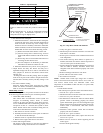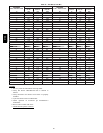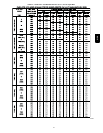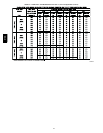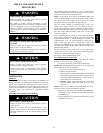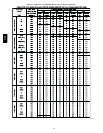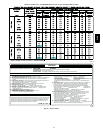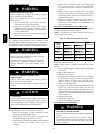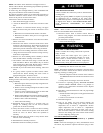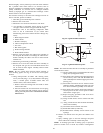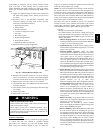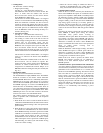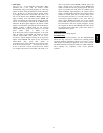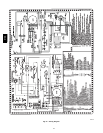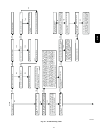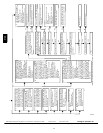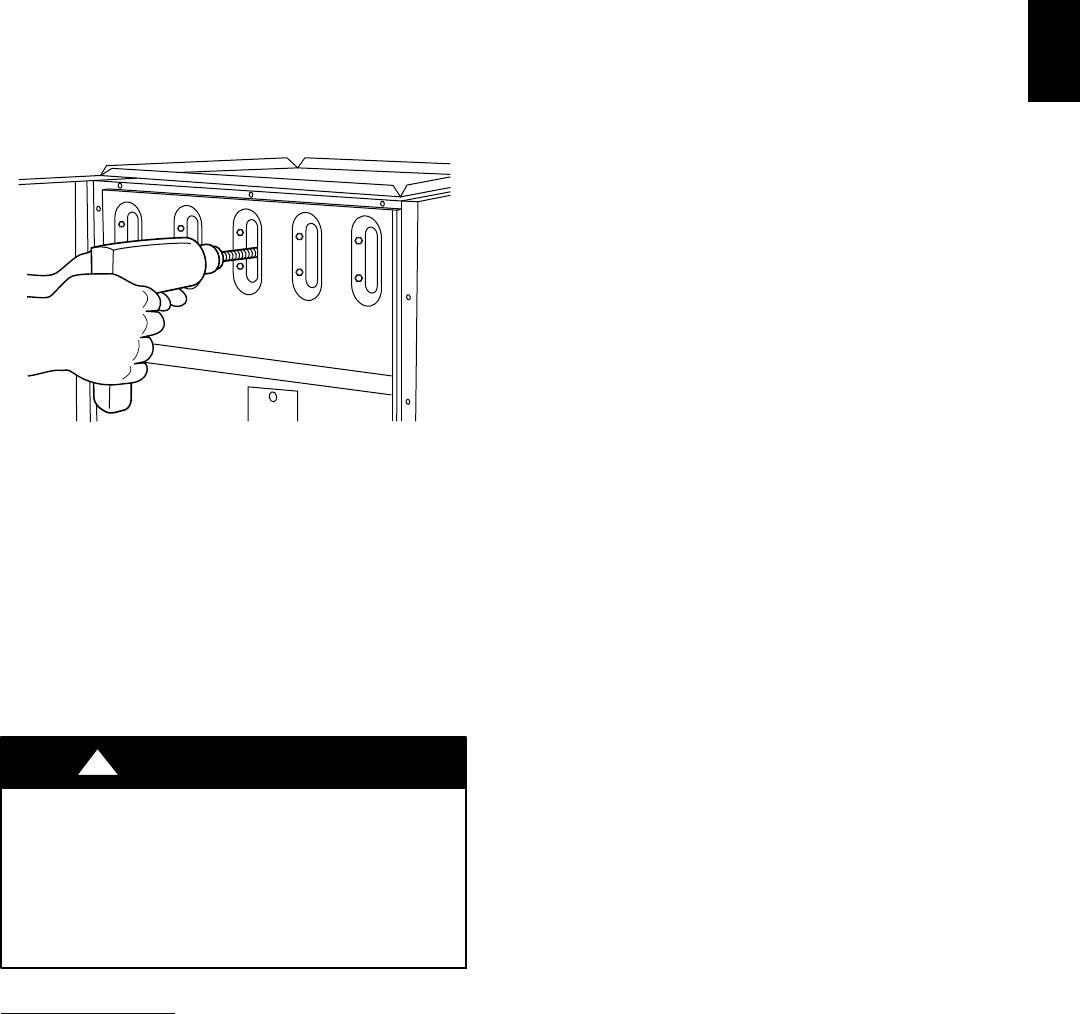
49
hydrocarbons or inadequate seal may occur) and RTV sealant
(G.E. 162, 6702, or Dow--Corning 738) are needed before
starting installation. DO NOT substitute any other type of RTV
sealant. G.E. 162 (P771-- 9003) is available through RCD in 3 --oz.
tubes.
12. Apply new sealant to flange of collector box and attach to
cell panel using existing screws, making sure all screws
are secure.
13. Reconnect wires to the following components. (Use
connection diagram on wiring label, if wires were not
marked for reconnection locations.):
a. Draft safeguard switch.
b. Inducer motor.
c. Pressure switch(es).
d. Limit over--temperature switch.
e. Gas valve.
f. Hot surface igniter .
g. Flame--sensing electrode.
h. Flame rollout switches.
i. Install NOx baffles (if removed).
14. Reinstall internal vent pipe, if applicable.
A91252
Fig. 58 -- Cleaning Heat Exchanger Cell
15. Reinstall vent connector on furnace vent elbow. Securely
fasten vent connector to vent elbow with 2 field --supplied,
corrosion--resistant, sheet metal screws located 180_ apart.
16. Replace blower access door only, if it was removed.
17. Set thermostat above room temperature and check furnace
for proper operation.
18. Verify blower airflow and s peed changes between heating
and cooling.
19. Check for gas leaks.
20. Replace outer access door.
FIRE OR EXPLOSION HAZARD
Failure to follow this warning could result in personal injury,
death and/or property damage.
Never purge a gas line into a combustion chamber. Never
test for gas leaks with an open flame. Use a c ommercially
available soap solution made specifically for the detection of
leaks to check all connections.
!
WARNING
Sequence of Operation
NOTE: Furnace control must be grounded for proper operation
or control will lock out. Control is grounded through
green/yellow wire routed to gas valve and manifold bracket
screw. Using the schematic diagram in Fig. 59, follow the
sequence of operation through the different modes. Read and
follow the wiring diagram very carefully.
NOTE: If a power interruption occurs during a call for heat (W),
the control will start a 90--second blower--only ON period two
seconds after power is restored, if the thermostat is still calling for
gas heating. The Amber LED light will flash code 12 during the
90--second period, after which the LED will be ON continuous,
as long as no faults are detected. After the 90--second period, the
furnace will respond to the thermostat normally.
The blower door must be installed for power to be conducted
through the blower door interlock switch ILK to the furnace
control CPU, transformer TRAN, inducer motor IDM, blower
motor BLWM, hot -- surface igniter HSI, and gas valve GV.
1. Heating
(See Fig. 25 for thermostat connections.)
The wall thermostat “calls for heat,” closing the R--to--W
circuit. The f urnace control performs a self--check, verifies
the pressure switch contacts PRS are open, and starts the
inducer motor IDM.
a. Inducer Prepurge Period-- As the inducer motor I DM
comesuptospeed,thepressureswitchcontactsPRSclose
to begin a 15-- second prepurge period.
b. Igniter W arm--Up-- At the end of the prepurge period,
the Hot--Surfaceigniter HSIis energized fora17--second
igniter warm--up period.
c. Trial--for-- Ignition Sequence-- When the igniter
warm-- up period is completed, the main gas valve relay
contactsGVRclosetoenergize thegasvalveGV, thegas
valve opens, and 24 vac power is supplied for a
field--installed humidifier at the HUM terminal. The gas
valve GV permits gas flow to the burners where it is
ignited by the HSI. Five seconds after the GVR closes,
a2--secondflameprovingperiodbegins.TheHSIigniter
willremainenergizeduntiltheflameis sensedor untilthe
2--second flame proving period begins.
d. Flame-- Proving-- Whentheburnerflameisprovedatthe
flame--proving sensorelectrodeFSE, thefurnacecontrol
CPU beginsthe blower-- ON delay period and continues
to hold thegas valveGV open.Ifthe burnerflame isnot
proved within two seconds, the control CPU will close
the gas valve G V, and the control CPU will repeat the
ignition sequence for up to three m ore
Trials--For--Ignition before going to Ignition--Lockout.
Lockout will be reset automatically after three hours or
by momentarily interrupting 1 15 vac power to the
furnace, or by interrupting 24 vac power at SEC1 or
SEC2 to the furnace control CPU (not at W, G, R, etc.).
Ifflameisproved when flameshould not be present, the
furnacecontrol CPU willlock outof Gas--Heating mode
and operate the inducer motor IDM until flame is no
longer proved.
e. Blower--On Delay-- If the burner flame is proven, the
blower motor is energized on HEAT speed 25 seconds
after the gas valve GV is energized.
Simultaneously, the electronic air cleaner terminal
EAC--1 is energized and remains energized as long asthe
blower motor BLWM is energized.
f. Blower--OffDelay--When thethermostatissatisfied,the
R--to--W circuit is opened, de--energizing the gas valve
GV, stopping gasflow to the burners, and de-- energizing
the humidifier terminal HUM. The inducer motor IDM
willremainenergized for a5 --second post-- purgeperiod.
The blower motor BLWM and air cleaner terminal
EAC--1 will remain energized for 90, 120, 150, or 180
seconds(dependingontheblower-- OFFdelayselection).
ThefurnacecontrolCPU isfactory-- setfora120--second
blower--OFF delay.
313A



